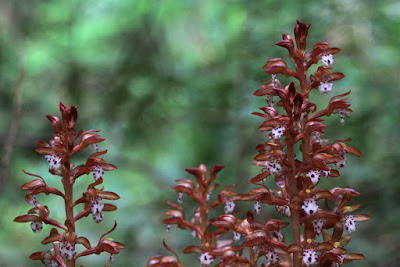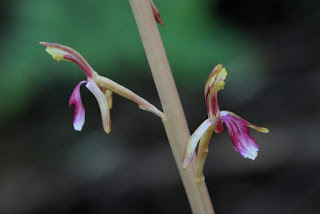May19-25
Managed to get out twice this week, once to Whidbey and Fidalgo Islands and once to several places in the Bellingham area. The Coralroots are at their peak and I saw three species that can be found locally, the Western Spotted Coralroot,
Corallorhiza maculata var. occidentalis, in several different color forms, the Western Coralroot,
Corallorhiza mertensiana, in a rainbow of colors (please note all the different stem and flower colors), but all the form that Paul MartinBrown calls
fma. pallida, and the Striped Coralroot,
Corallorhiza striata var. striata in a rather pale color form. I found a few Western Fairy Slippers,
Calypso bulbosa var. occidentalis, and took pictures of one, but they are nearly finished at these lower elevations, though in the mountains they are either at their peak or have not even started to bloom yet.
Corallorhiza maculata var. occidentalis
Western Spotted Coralroot
with a stem holding last year's seed-pods
Corallorhiza maculata var. occidentalis fma. intermedia
Western Spotted Coralroot (brown-stemmed form)
Corallorhiza mertensiana fma. pallida
Western Coralroot (pale form)
with old stem holding last year's seed-pods
Corallorhiza striata var. striata
Striped Coralroot
Calypso bulbosa var. occidentalis
Western Fairy Slipper




































8 comments:
Phenomenal as always, Ron! It's been a fun orchid season for us in the east so far as well. I'm heading up to upstate New York this upcoming week for some hiking and botanizing. Hope to see some orchids! I did manage to finally see our eastern Cypripedium hybrid last weekend; gorgeous plants :)
Thanks for checking up on my blog, Andrew. Next week should be really exciting as we are going to see one of the few locations for Cyp. parviflorum in the state. Now to see what you've been up to.
After reading some nice stuff in your article On Northwest.I really feel speechless, because it is quit pretty article. Beside this it is also a long lasting article. Thanks for giving me such type of useful information..
Thanks for checking this latest post and commenting. Glad the information is useful.
Hi Ron,
that thing about the hybrid sounds very interesting. It would be interesting to know if it is a big population of parent plants. It is consensus here, that the bigger the parent populations, the less likely hybridization is (unless there are two legged "helpers", as is often the case with our orchids - especially with Ophrys - not a good thing).
However beautiful pictures of the ladyslippers and the coralroots. From the pictures I like C. mertensiana the best.
On a different note: I finally found Calypso bulbosa in northern Sweden. It looks quite different from your subspecies. The lip is more unicolored. A lovely plant - kind of tiny, but very easy to find, if you know where to look. I was very lucky in that northern Europe has an early season, while we ave a very late one. Weird year. But... so far the best orchid season in a long time.
--Martin
Hi Martin,
Welcome back and nice to hear about your trip. Am eager to get to your blog to see your pictures, but thought I'd respond here first. Appreciate your taking the time to look and comment.
The population of Lady's Slippers is quite large (100+ plants), but the two species seem to hybridize freely and some believe that almost all the populations are mixed. No human help in this case, though.
We found Calypso bulbosa var. americana this week in eastern Washington. Quite different from our western variety and I'll be posting some pictures later today. They are tiny, aren't they.
Lovely images, Ron! Several years ago, I was finally able to see Corallorhiza mertensiana, but it was in tight bud. :-(. Well, maybe next time...
Jim Fowler, Greenville, SC
It's kind of an odd species, Jim. When we find it, it's usually quite abundant but it can be quite localized. It also comes in a variety of color forms that are a delight to examine. One area we know has just some very dark forms, but most locations have a rainbow of colors.
Post a Comment